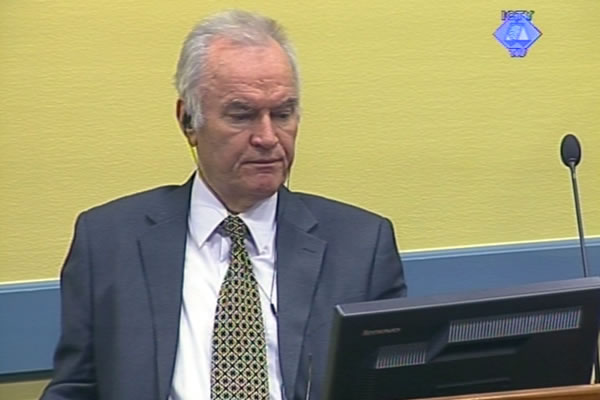Home
BUS MASSACRE DESCRIBED IN ABSENCE OF ACCUSED
At the trial of Ratko Mladic, a witness described the events of 14 June 1992, when he and about 50 men were put on a bus. In the village of Sokolina, the bus was stopped and fire was opened at it from various weapons: anti-tank missiles, machine guns, automatic rifles and hand grenades were used. The mutilated bodies of the victims were recovered from the bus the next day. The witness tried to identify the victims ‘based on their clothes or shoes because few of them had not suffered any damage to their faces’
 Ratko Mladic in the courtroom
Ratko Mladic in the courtroom After Ratko Mladic refused this morning to enter the courtroom because video link testimony made it impossible for him to ‘participate directly in examining the witness’, the Chamber decided his refusal was tantamount to a voluntary waiver of his right to attend the trial and proceeded to hear protected witness RM 145 in the absence of the accused.
According to a summary of the witness statement read out by the prosecutor, in 1992 the witness lived in a village in Novi Grad, a municipality which was part of Sarajevo. After an attack on the village, about 30 people tried to flee but were ambushed and surrendered. The witness claims that Jovo Tintor, an SDS official and the war chief of the municipality of Vogosca, took them to a JNA barracks where they were ‘beaten, mistreated and threatened with death’. They were then moved to a military depot in Rajlovac. The witness was detained in an empty fuel tank. As the indictment alleges, in the first half of June, a man nicknamed Zuti took two groups of men, 10 to 15 men each, from the tank. They were never seen again.
The witness was taken out from the tank in Rajlovac on 14 June and was put on a bus together with about 50 people. The bus was stopped in Sokolina; purportedly, some water had to be added to the cooling system. As soon as the driver and the escort got off, fire was opened on the bus ‘from every weapon there is’ as the witness said: machine guns, automatic rifles, anti-tank missiles. Hand grenades were lobbed at the bus. ‘The shooting lasted for about 15 minutes,’ the witness said. He was wounded in the left arm.
After the Serb forces left the scene of the massacre, the witness managed to flee into a village nearby, together with his surviving relative. The villagers and the local Territorial Defense went to the bus in the morning of 15 June to recover and bury the victims of the massacre. This event was recorded on video, which was shown today in court. During the burial, the witness was trying to identify the mutilated victims ‘based on their clothes, shoes… because few of them had not suffered any damage to their faces’.
The defense counsel put it to the witness that the paramilitaries were responsible for the attack on Novi Grad and that the people in the witness’s village were well armed; in fact, the defense counsel claimed, they managed to fight off an attack of the Serb forces for two days in late May 1992. As the witness explained, his village was first shelled by the JNA and then it was overrun by the paramilitaries, accompanied by tanks and armored vehicles. ‘There was general chaos after that and people fled’. The defense lawyer then put it to the witness that the camp in Rajlovac was secured by people wearing blue uniforms, similar to those worn by the police. According to the witness, such uniforms were worn by the personnel of the Orao Air Force Installation; this means the guards were soldiers.
The witness confirmed that he couldn’t see any of the perpetrators of the crime after the bus was fired on. He heard one of them say to another to get on the bus and check for survivors. ‘Go in yourself if you’re that curious’, the other man said, and the witness heard them slam the car doors and leave.
After the protected witness completed his evidence, former JNA colonel Osman Selak returned to court to be cross-examined by the defense. Mladic’s lawyer put it to him that in April 1992 the Democratic Action Party (SDA) was busy running a smear campaign against the JNA and that some Bosniak officers had gone over to the Territorial Defense. At that time, the JNA was already seen as a foreign occupying force in Bosnia and Herzegovina, Selak responded. When he was asked if he shared the view, being a JNA colonel, Selak said, ‘I was and remained a patriot for all three ethnic communities, not just one’. His evidence will resume tomorrow.